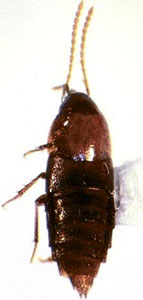Gymnusini
James S. Ashe (1947-2005) and Stylianos ChatzimanolisIntroduction
The Gymnusini are a small group of basal aleocharines that are inhabitants of marshes, bogs, pond and stream edges and similar riparian habitats. They are often found by treading moss and detritus in marshy or boggy areas.
The Gymnusini have an unusual amphitropical distribution with Gymnusa widespread in the northern hemisphere (Nearctic and Palearctic faunal Regions) and Stylogymnusa found only on the Auckland Islands off the southern coast of New Zealand (Australian faunal region).
Characteristics
Adults of Gymnusini are characterized by: fusiform shape with deflexed head; lack of a tergal gland opening on abdominal tergum VII; pectinate edge of abdominal segments III-V, distinctive mouthparts (for details see Klimaszewski 1979 and the Gymnusa and Stylogymnusa pages); 6 setigerous pores on the dorsal surface of the head; male tergum IX entire (not divided) and, 5-5-5 tarsal segmentation.
Discussion of Phylogenetic Relationships
Hammond (1975) proposed that Gymnusa and Stylogymnusa comprise the monophyletic tribe Gymnusini based on the shared apomorphic characteristics of large mentum, 6 setigerous pores on the dorsum of the head, and similarities in the mouthparts. Klimaszewski (1979, 1982) supported this relationship. Ashe (2000) produced a phylogeny that provided strong support for a monophyletic lineage consisting of Gymnusa, Stylogymnusa and the tribe Deinopsini, but found only weak support for a monophyletic Gymnusini. The mouthparts of Gymnusa share a number of derived features with mouthparts of members of the Deinopsini; most derived features presumably shared between Gymnusa and Stylogymnusa as proposed by Hammond (1975) and Klimaszewski (1979) were shown to be based on misinterpretations of mouthpart structure. However, Gymnusa and Stylogymnusa uniquely share the presence of 6 setigerous pores on the dorsum of the head; this feature is not known to occur among any other lineage of basal aleocharines, or among other potential out-groups within the Tachyporine Lineage (Ashe 2000). Currently the evidence for a monophyletic Gymnusini is contradictory, and the issue remains unresolved.
References
Ashe, J. S. 2000. Mouthpart structure of Stylogymnusa subantartica Hammond, 1975 (Coleoptera: Staphylinidae: Aleocharinae) with a reanalysis of the phylogenetic position of the genus. Zoological Journal of the Linnean Society 130: 471-498.
Hammond, P. 1975. The phylogeny of a remarkable new genus and species of gymnusine staphylinid (Coleoptera) from the Auckland Islands. Journal of Entomology (B) 44(2): 153-173.
Klimaszewski, J. 1979. A revision of the Gymnusini and Deinopsini of the World. Canada Agriculture monograph No. 25. 169 pp.
Klimaszeski, J. 1982. A revision of the Gymnusini and Deinopsini of the world. Sup. 2. Canadian Entomologist 114: 317-335.
Title Illustrations

| Scientific Name | Gymnusa pseudovariagata |
|---|---|
| Location | Canada (B. C.) |
| Size | length 5.8 mm |
| Copyright |
© 1997 James S. Ashe (1947-2005)

|
| Scientific Name | Stylogymnusa subantarctica |
|---|---|
| Location | Auckland Island, New Zealand |
| Size | length 3.2 mm |
| Copyright |
© 1997 James S. Ashe (1947-2005)

|
About This Page
Development of this page made possible by National Science Foundation PEET grants DEB 95-21755 and DEB 99-78110 to James S. Ashe.
All images on this page copyright © 1997-2003 James S. Ashe.
James S. Ashe (1947-2005)

University of Kansas, Lawrence, Kansas, USA
Stylianos Chatzimanolis

University of Tennessee at Chattanooga
Page copyright © 1997 James S. Ashe (1947-2005) and Stylianos Chatzimanolis
All Rights Reserved.
- First online 29 August 1997
- Content changed 06 November 2003
Citing this page:
Ashe (1947-2005), James S. and Stylianos Chatzimanolis. 2003. Gymnusini. Version 06 November 2003. http://tolweb.org/Gymnusini/9814/2003.11.06 in The Tree of Life Web Project, http://tolweb.org/











 Go to quick links
Go to quick search
Go to navigation for this section of the ToL site
Go to detailed links for the ToL site
Go to quick links
Go to quick search
Go to navigation for this section of the ToL site
Go to detailed links for the ToL site